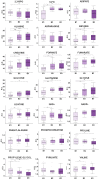Metabolic footprint of aging and obesity in red blood cells
- PMID: 33609087
- PMCID: PMC7950240
- DOI: 10.18632/aging.202693
Metabolic footprint of aging and obesity in red blood cells
Abstract
Aging is a physiological process whose underlying mechanisms are still largely unknown. The study of the biochemical transformations associated with aging is crucial for understanding this process and could translate into an improvement of the quality of life of the aging population. Red blood cells (RBCs) are the most abundant cells in humans and are involved in essential functions that could undergo different alterations with age. The present study analyzed the metabolic alterations experienced by RBCs during aging, as well as the influence of obesity and gender in this process. To this end, the metabolic profile of 83 samples from healthy and obese patients was obtained by Nuclear Magnetic Resonance spectroscopy. Multivariate statistical analysis revealed differences between Age-1 (≤45) and Age-2 (>45) subgroups, as well as between BMI-1 (<30) and BMI-2 (≥30) subgroups, while no differences were associated with gender. A general decrease in the levels of amino acids was detected with age, in addition to metabolic alterations of glycolysis, the pentose phosphate pathway, nucleotide metabolism, glutathione metabolism and the Luebering-Rapoport shunt. Obesity also had an impact on the metabolomics profile of RBCs; sometimes mimicking the alterations induced by aging, while, in other cases, its influence was the opposite, suggesting these changes could counteract the adaptation of the organism to senescence.
Keywords: NMR; RBCs; aging; metabolomics; obesity.
Conflict of interest statement
Figures







Similar articles
-
Parabiosis Incompletely Reverses Aging-Induced Metabolic Changes and Oxidant Stress in Mouse Red Blood Cells.Nutrients. 2019 Jun 14;11(6):1337. doi: 10.3390/nu11061337. Nutrients. 2019. PMID: 31207887 Free PMC article.
-
Fecal and urinary NMR-based metabolomics unveil an aging signature in mice.Exp Gerontol. 2014 Jan;49:5-11. doi: 10.1016/j.exger.2013.10.010. Epub 2013 Oct 29. Exp Gerontol. 2014. PMID: 24184118
-
Time-Course Investigation of Small Molecule Metabolites in MAP-Stored Red Blood Cells Using UPLC-QTOF-MS.Molecules. 2018 Apr 16;23(4):923. doi: 10.3390/molecules23040923. Molecules. 2018. PMID: 29659551 Free PMC article.
-
[Human red cell metabolism and its pathophysiology].Nihon Rinsho. 1996 Sep;54(9):2326-30. Nihon Rinsho. 1996. PMID: 8890558 Review. Japanese.
-
Purinergic control of red blood cell metabolism: novel strategies to improve red cell storage quality.Blood Transfus. 2017 Oct;15(6):535-542. doi: 10.2450/2017.0366-16. Epub 2017 Apr 12. Blood Transfus. 2017. PMID: 28488967 Free PMC article. Review.
Cited by
-
Erythrocyte Oxidative Status in People with Obesity: Relation to Tissue Losses, Glucose Levels, and Weight Reduction.Antioxidants (Basel). 2024 Aug 7;13(8):960. doi: 10.3390/antiox13080960. Antioxidants (Basel). 2024. PMID: 39199206 Free PMC article.
-
Probiotic Foods Are Effective on Weight Loss, Biochemical Parameters, and Intestinal Microbiota in Wistar Albino Rats with Obese Microbiota.Int J Clin Pract. 2022 Mar 3;2022:4569100. doi: 10.1155/2022/4569100. eCollection 2022. Int J Clin Pract. 2022. PMID: 35685527 Free PMC article.
-
Sports Participation Promotes Beneficial Adaptations in the Erythrocyte Guanylate Nucleotide Pool in Male Athletes Aged 20-90 Years.Clin Interv Aging. 2023 Jun 22;18:987-997. doi: 10.2147/CIA.S406555. eCollection 2023. Clin Interv Aging. 2023. PMID: 37377627 Free PMC article.
-
Erythrocyte nicotinamide adenine dinucleotide concentration is enhanced by systematic sports participation.BMC Sports Sci Med Rehabil. 2024 Oct 15;16(1):216. doi: 10.1186/s13102-024-00999-y. BMC Sports Sci Med Rehabil. 2024. PMID: 39407226 Free PMC article.
-
Arginine metabolism is a biomarker of red blood cell and human aging.Aging Cell. 2025 Feb;24(2):e14388. doi: 10.1111/acel.14388. Epub 2024 Oct 30. Aging Cell. 2025. PMID: 39478346 Free PMC article.
References
-
- United Nations. Department of Economic and Social Affairs. World population ageing 2019: Highlights. United Nations. Department of Economic and Social Affairs. 2019; 40–1307.
Publication types
MeSH terms
LinkOut - more resources
Full Text Sources
Other Literature Sources
Medical

